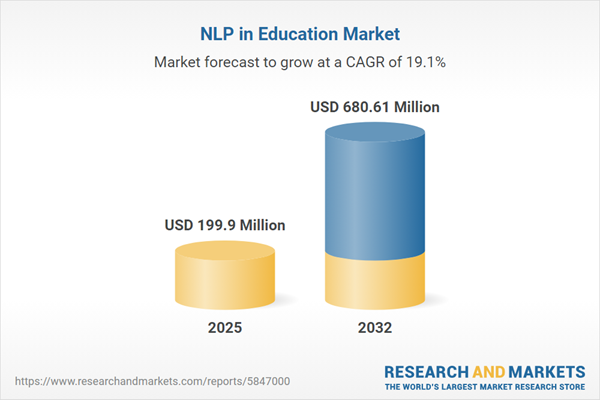Speak directly to the analyst to clarify any post sales queries you may have.
The NLP in Education Market is transforming how institutions address digital transformation, operational agility, and collaboration needs. As senior leaders drive modernization, natural language processing is delivering powerful routes to more efficient learning environments and streamlined administration.
Market Snapshot: NLP in Education Market Growth and Opportunity
With mounting attention to digital solutions, the NLP in Education Market continues to expand across academic and workplace sectors. Adoption is gaining momentum among universities, K-12 schools, and workforce training programs, integrating NLP technologies to advance instruction and optimize administrative operations. This trend results in the acceleration of flexible, hybrid, and remote learning models, supporting improved educator-learner engagement and more efficient team collaboration for geographically dispersed staff. As these frameworks prove both scalable and adaptable, institutions are able to respond confidently to evolving demands around digital strategy and educational delivery.
NLP in Education Market: Scope & Segmentation
This report equips executive decision-makers with in-depth intelligence related to NLP technology adoption, strategic investment, and effective digital transformation at the institutional level. The study segments the market to cover all critical areas impacting education technology leadership:
- Application Areas: Administrative automation, enrollment management, digital assessments, adaptive language learning, intelligent tutoring, and conversational chatbots are supporting targeted improvements in higher education, K-12, and ongoing professional development.
- Component Types: Consulting services, integration support, APIs, technical assistance, and configurable platforms are ensuring robust solutions, smooth technology integration, and reliable upgrade transitions.
- Deployment Models: Cloud-based and on-premise options present leaders with the flexibility required to manage scale, maintain regulatory compliance, and adapt governance frameworks to their needs.
- Offering Types: Licensing and subscription models give flexibility to fit various budgets and operational timelines, accommodating both pilot projects and long-term implementations.
- End User Segments: Corporate learning teams, higher education institutions, and K-12 school systems are leveraging NLP for enhanced learning experiences across a wide spectrum of learner profiles.
- Geographic Coverage: Regional strategy guidance and compliance insights span North America, Latin America, Europe, Middle East, Africa, and Asia-Pacific, supporting institutions navigating local regulatory and localization issues.
- Company Profiles: Analysis includes Duolingo, Pearson, Chegg, Coursera, John Wiley & Sons, IBM, Turnitin, Carnegie Learning, Knewton, and Busuu, highlighting unique strategies and technology adaptation in the education sector.
Key Takeaways for Senior Decision-Makers
- Adaptive NLP platforms enable personalized learning experiences, aligning instructional techniques with evolving curriculum needs for measurable instructional gains.
- Automated grading and assessment solutions redistribute faculty resources, allowing a greater focus on teaching excellence and reinforcing effective feedback to learners.
- Cloud-based deployment unlocks fast, scalable technology onboarding, making it ideal for multi-campus institutions or those serving remote learners.
- AI-powered chatbots and virtual assistants deliver round-the-clock access to educational resources and administrative support, minimizing incremental overhead as demand grows.
- Close collaboration between educators and solution providers strengthens compliance and quality standards, supporting the navigation of rapidly changing digital environments.
- Flexible deployment and procurement strategies allow for faster adaptation to shifting policies, market conditions, or internal priorities without disrupting ongoing operations.
Tariff Impact: U.S. Policies Reshaping Cost and Procurement
Recent changes to U.S. tariff policy have increased the cost of hardware for NLP adoption, leading more institutions to choose cloud-based implementations. Collaborating with domestic vendors now helps institutions reduce reliance on imports, enhance procurement continuity, and lessen disruptions from fluctuating supply chains.
Methodology & Data Sources
The findings in this report are derived from a comprehensive synthesis of industry publications, expert interviews, and specialized surveys. Rigorous secondary research validates the conclusions, empowering leaders to make evidence-based plans and informed technology selections.
Why This Report Matters
- Acts as a reliable benchmark for evaluating strategies and deployments in the NLP in Education Market, supporting senior decision-makers invested in digital progress.
- Clarifies how market segments and regions influence institutional procurement, investment, and regulatory planning for education leaders facing technological change.
- Equips organizations with actionable intelligence to align digital portfolios, develop adaptive curriculum strategies, and enable forward-looking planning reflective of emerging trends.
Conclusion
NLP technologies are reshaping institutional operations and learning models throughout the education landscape. With insights from this report, leaders can approach organizational change with confidence and reinforce the long-term resilience of their institutions.
Additional Product Information:
- Purchase of this report includes 1 year online access with quarterly updates.
- This report can be updated on request. Please contact our Customer Experience team using the Ask a Question widget on our website.
Table of Contents
3. Executive Summary
4. Market Overview
7. Cumulative Impact of Artificial Intelligence 2025
Companies Mentioned
The companies profiled in this NLP in Education market report include:- Duolingo, Inc.
- Pearson PLC
- Chegg, Inc.
- Coursera, Inc.
- John Wiley & Sons, Inc.
- International Business Machines Corporation
- Turnitin, LLC
- Carnegie Learning, Inc.
- Knewton, Inc.
- Busuu GmbH
Table Information
| Report Attribute | Details |
|---|---|
| No. of Pages | 193 |
| Published | November 2025 |
| Forecast Period | 2025 - 2032 |
| Estimated Market Value ( USD | $ 199.9 Million |
| Forecasted Market Value ( USD | $ 680.61 Million |
| Compound Annual Growth Rate | 19.1% |
| Regions Covered | Global |
| No. of Companies Mentioned | 11 |









